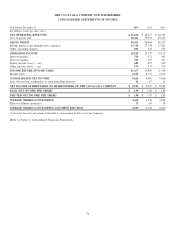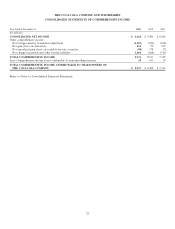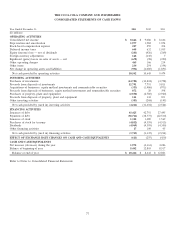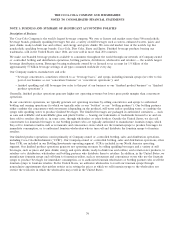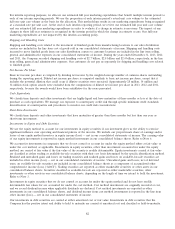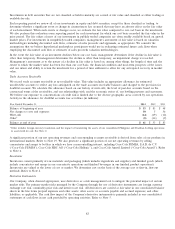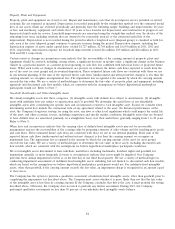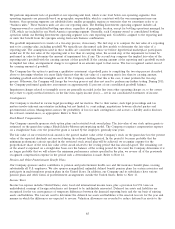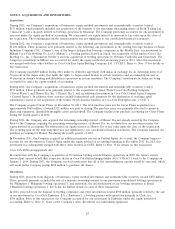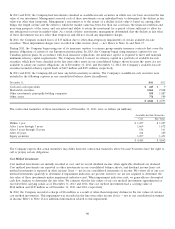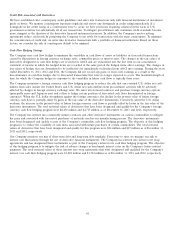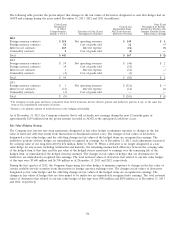Coca Cola 2013 Annual Report Download - page 86
Download and view the complete annual report
Please find page 86 of the 2013 Coca Cola annual report below. You can navigate through the pages in the report by either clicking on the pages listed below, or by using the keyword search tool below to find specific information within the annual report.Property, Plant and Equipment
Property, plant and equipment are stated at cost. Repair and maintenance costs that do not improve service potential or extend
economic life are expensed as incurred. Depreciation is recorded principally by the straight-line method over the estimated useful
lives of our assets, which are reviewed periodically and generally have the following ranges: buildings and improvements: 40 years
or less; and machinery, equipment and vehicle fleet: 20 years or less. Land is not depreciated, and construction in progress is not
depreciated until ready for service. Leasehold improvements are amortized using the straight-line method over the shorter of the
remaining lease term, including renewals that are deemed to be reasonably assured, or the estimated useful life of the
improvement. Depreciation is not recorded during the period in which a long-lived asset (disposal group) is classified as held for
sale, even if the asset (disposal group) continues to generate revenue during the period. Depreciation expense, including the
depreciation expense of assets under capital lease, totaled $1,727 million, $1,704 million and $1,654 million in 2013, 2012 and
2011, respectively. Amortization expense for leasehold improvements totaled $16 million, $19 million and $18 million in 2013,
2012 and 2011, respectively.
Certain events or changes in circumstances may indicate that the recoverability of the carrying amount of property, plant and
equipment should be assessed, including, among others, a significant decrease in market value, a significant change in the business
climate in a particular market, or a current period operating or cash flow loss combined with historical losses or projected future
losses. When such events or changes in circumstances are present, we estimate the future cash flows expected to result from the
use of the asset (or asset group) and its eventual disposition. These estimated future cash flows are consistent with those we use
in our internal planning. If the sum of the expected future cash flows (undiscounted and without interest charges) is less than the
carrying amount, we recognize an impairment loss. The impairment loss recognized is the amount by which the carrying amount
exceeds the fair value. We use a variety of methodologies to determine the fair value of property, plant and equipment, including
appraisals and discounted cash flow models, which are consistent with the assumptions we believe hypothetical marketplace
participants would use. Refer to Note 7.
Goodwill, Trademarks and Other Intangible Assets
We classify intangible assets into three categories: (1) intangible assets with definite lives subject to amortization, (2) intangible
assets with indefinite lives not subject to amortization and (3) goodwill. We determine the useful lives of our identifiable
intangible assets after considering the specific facts and circumstances related to each intangible asset. Factors we consider when
determining useful lives include the contractual term of any agreement related to the asset, the historical performance of the
asset, the Company’s long-term strategy for using the asset, any laws or other local regulations which could impact the useful life
of the asset, and other economic factors, including competition and specific market conditions. Intangible assets that are deemed
to have definite lives are amortized, primarily on a straight-line basis, over their useful lives, generally ranging from 1 to 20 years.
Refer to Note 8.
When facts and circumstances indicate that the carrying value of definite-lived intangible assets may not be recoverable,
management assesses the recoverability of the carrying value by preparing estimates of sales volume and the resulting gross profit
and cash flows. These estimated future cash flows are consistent with those we use in our internal planning. If the sum of the
expected future cash flows (undiscounted and without interest charges) is less than the carrying amount, we recognize an
impairment loss. The impairment loss recognized is the amount by which the carrying amount of the asset (or asset group)
exceeds the fair value. We use a variety of methodologies to determine the fair value of these assets, including discounted cash
flow models, which are consistent with the assumptions we believe hypothetical marketplace participants would use.
We test intangible assets determined to have indefinite useful lives, including trademarks, franchise rights and goodwill, for
impairment annually, or more frequently if events or circumstances indicate that assets might be impaired. Our Company
performs these annual impairment reviews as of the first day of our third fiscal quarter. We use a variety of methodologies in
conducting impairment assessments of indefinite-lived intangible assets, including, but not limited to, discounted cash flow models,
which are based on the assumptions we believe hypothetical marketplace participants would use. For indefinite-lived intangible
assets, other than goodwill, if the carrying amount exceeds the fair value, an impairment charge is recognized in an amount equal
to that excess.
The Company has the option to perform a qualitative assessment of indefinite-lived intangible assets, other than goodwill, prior to
completing the impairment test described above. The Company must assess whether it is more likely than not that the fair value
of the intangible asset is less than its carrying amount. If the Company concludes that this is the case, it must perform the testing
described above. Otherwise, the Company does not need to perform any further assessment. During 2013, the Company
performed qualitative assessments on less than 10 percent of our indefinite-lived intangible assets balance.
84


